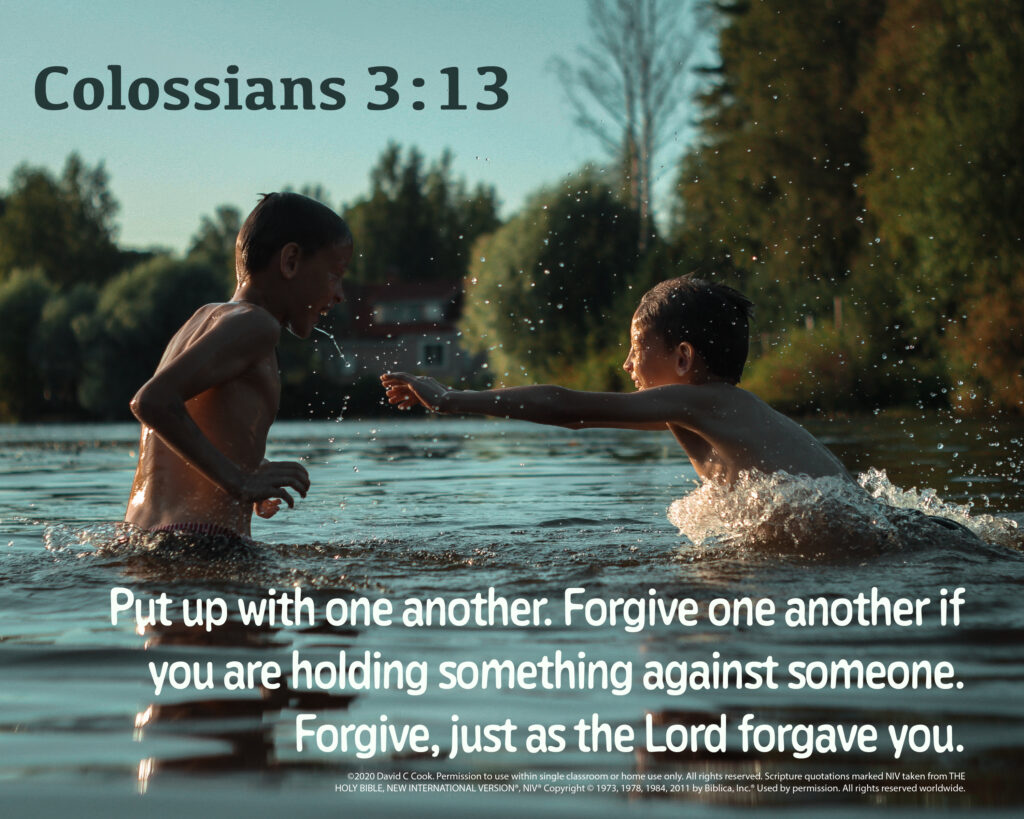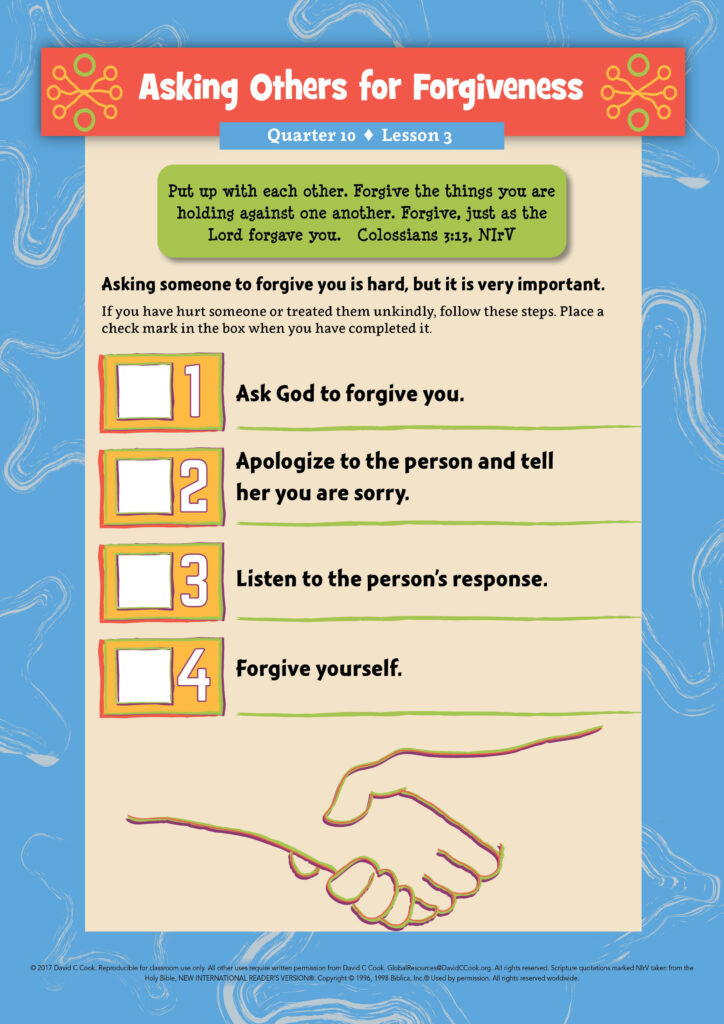During the lesson, the information for you to know is written in regular type, and what we suggest speaking or reading aloud to children is in bold. All resources for this lesson, including the Teacher Guide, Student Page, Family Connection Card, and other resources can be downloaded in a ZIP file by clicking on the following link:
In some lessons you will find "resource articles." These are articles written by experts from around the world to help equip you for your work with children and adolescents. Share them with parents or guardians if you consider it appropriate.
Put up with each other. Forgive the things you are holding against one another. Forgive, just as the Lord forgave you.
Colossians 3:13, NIrV
Each one of us has sinned, and our sin has hurt someone. When you confess your sin to God, He faithfully forgives you! But God also wants your relationships with others to be restored. Think about those you have sinned against. Pray through these forgiveness steps to begin the restoration process:
If you need to ask someone for forgiveness, go to him this week if possible. God wants us to live in the freedom that comes from receiving forgiveness from Him and others.
Let the families of your children know that this week they will learn about asking others for forgiveness. Encourage families to ask their children about the 4 steps they can follow when asking for forgiveness.
Teacher Tip: If possible, email or text the Family Connection Card to the families of your students.
Start the class with a game to help the children learn more about forgiveness. Create 4 pairs of children. Put boys with boys and girls with girls. Give 1 child in each pair the bag of heavy items. The other children can cheer for a team.
The child in your pairs with the heavy bag will be Load Giver and the other will be Runner. Go line up with your partner on one side of our space. Listen carefully to this situation and follow my instructions.
Load Giver has said or done something hurtful to Runner. Runner is so hurt she does not think she can forgive Load Giver. She is weighed down with this pain and cannot stop thinking about the hurt.
Tell each Load Giver to give her heavy bag to her partner, Runner.
Load Giver will stand behind Runner with her hands on Runner’s shoulders. This shows that Runner’s lack of forgiveness weighs her down. Her freedom is limited. The Load Giver must not let go of Runner’s shoulders until the load is dropped.
When I say, “Go!” each Runner will walk to the other side of our space. The pairs must stay together.
When you get to the other side, Load Giver will ask Runner for forgiveness. Runner will say, “I forgive you” and drop the heavy load. Then Load Giver will let go of Runner, and together they will race back to the other side.
Yell “Go!” and allow the children to move across the space. Help when necessary to be sure that no one is hurt. After all pairs have run back to the start, have the children sit down. Ask the following questions, allowing 2 children to share their answers for each:
Last week we talked about accepting God’s forgiveness. Today we will talk more about forgiveness.
Who remembers what forgiveness is?
Forgiveness is letting go of a hurt or offense that was done to us. It does not mean that what happened to us is right. But it does mean that we choose not to allow what happened weigh us down, as Load Giver weighed down Runner. When we forgive, we let go of our anger and bitterness. For Christians, this also means that we trust God to decide the consequences for that wrong.
It is important that we learn how to forgive others and how to accept forgiveness. Forgiving is hard, but God wants us to forgive. Listen to this story in the Bible about 2 brothers who had a problem with forgiveness.
Optional: If you are using The Action Bible, children can read the stories on pages 68–75.
At the time of the Old Testament, the oldest son received the birthright and a special blessing. The birthright gave him twice as much of the father’s wealth as his brothers received.
Do you remember Abraham and his miracle son, Isaac? Isaac and his wife, Rebekah, had twin boys, Esau and Jacob. Esau was the older son. He was supposed to receive the birthright and special blessing.
Esau was Isaac’s favourite son. Esau was a great hunter and a very hairy man. Jacob, the younger son, was Rebekah’s favourite. He preferred to stay in the family’s tents.
One day Esau came home after a long day of hunting. He was very hungry. Jacob had made some stew. Esau said to his brother, “I am starving. Give me some of your stew.” Jacob said he would share the stew if Esau would give Jacob his birthright. Esau agreed to trade his birthright for a bowl of stew. What a foolish thing to do! He gave away a double portion of his father’s wealth for something to eat.
Many years later, when Isaac was old and blind, he asked Esau to go hunting. Isaac promised that he would bless Esau when he returned.
Optional: If possible, share the images from The Action Bible.

While Esau was hunting, Jacob and his mother decided to trick blind Isaac into thinking that Jacob was Esau in order to steal his blessing. Rebekah made stew that Isaac liked. Jacob dressed in Esau’s clothes and put animal skins on his arms and neck so he would feel hairy and smell like Esau. Jacob took the stew to his father. When Isaac smelled Esau’s clothes and felt the animal hair on Jacob’s arms and neck, he thought he was talking to Esau and gave the blessing to Jacob.
Esau returned with fresh meat only to find out that his younger brother had tricked their father. Esau was so angry that he wanted to kill Jacob. Afraid for his life, Jacob ran away to a distant land to stay with his mother’s relatives.
When someone has hurt you, it is normal to be angry and hurt. But if you do not learn to forgive that person, that anger and hurt can turn to bitterness and cause you a lot of pain inside. That is like carrying the load in our game and not being free to move forward.
Many years later, Jacob wanted to return home. He was afraid Esau might still want to kill him. He hoped his brother would accept him. As the 2 brothers approached each other, Jacob bowed down to the ground 7 times.
Each of us has hurt someone else through our words or our actions. We all need to ask for forgiveness from someone. The Bible does not tell us if Jacob asked Esau for forgiveness, but we do see that their relationship was restored. Let’s hear a Bible verse about why we forgive each other.
If you are using the Memory Verse Poster, show it to the students.
Put up with one another. Forgive one another if you are holding something against someone. Forgive, just as the Lord forgave you.
Colossians 3:13, NIrV

We all sin against others and hurt them, as Jacob sinned against Esau. But how do you ask someone for forgiveness? Here are some steps that will help you ask for forgiveness when you have hurt someone else.
Read the following steps to the children. Have the children hold up a different finger for each step. This type of action will help them remember the steps. Emphasize the underlined words.
Repeat the steps again, holding up a finger for each step. See if the children can remember the short underlined phrases without your help.
Now let’s practice these steps. Find a partner and choose who will be Friend 1 and who will be Friend 2. I will read a situation. After I read the situation, Friend 2 will have the opportunity to respond in 1 of 2 ways:
Remember to use the steps we just learned. Ask God for forgiveness. Apologize to the person. Listen to her response. Forgive yourself.
Now that you have practiced in a pretend situation, I want you to think about a real situation in your life. Do not answer this question out loud. Just think about your answer.
The person you need to ask to forgive you may have died or moved away. It may not be safe for you to talk to the person. You still need to ask for forgiveness. So, share your situation with God. Ask Him to forgive you. Then ask God to help that person to forgive you so he can be freed from the weight of unforgiveness. If you are not ready to talk with God, you can always talk with a trusted adult about your situation.
Optional: If you are using the Student Pages, have the children do a forgiveness activity on them.

Close class by speaking this blessing over the children, which includes Colossians 3:13.
Blessing: May you put up with one another and forgive one another. May God help you forgive just as He forgives you. He wants your heart to be free!
Lead the children in singing this quarter’s song, if possible.
Life on Life ©2020 David C Cook. Reproducible for home or classroom use only. All other uses require written permission from David C Cook [email protected]. All rights reserved.